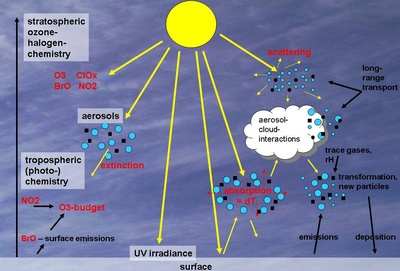Research
Ozone, Uv and aerosol studies and modelling of the atmospheric composition
The RMI has a long tradition of observations of atmospheric ozone. These are carried out both with UV spectrophotometers (which measure the total column) and balloon soundings (which measure the vertical profile). Variations in the amount of ozone in the atmosphere affect the intensity of UV radiation reaching the ground. The spectrophotometers we use to observe the ozone column also measure the spectrum of UV radiation near the ground. Not only ozone, but aerosol particles also affect the amount of incoming UV radiation due to their optical properties. Recently, some instruments were installed that map some of the physical properties of aerosol particles in the atmosphere. For example, these instruments measure both the number and size of these particles, as well as the absorption and scattering of light. Moreover, a network of 5 ceilometers in Belgium monitors the vertical profile of larger aerosol particles (e.g. dust transported from the Sahara or from forest fires, volcanic eruptions).

All these instruments require maintenance and quality control. The observations are used in scientific studies that map long-term trends, for example. In addition, the knowledge thus gathered about these parameters is used to make predictions of UV radiation intensity. This is important to inform the population about the possible harmful effects of high doses of UV radiation.
Further, our group is also responsible for the validation of satellite products such as ozone profiles. This validation work is done in the framework of the Satellite Application Facility on Atmospheric Composition (AC SAF) of EUMETSAT, the European organisation for the development and management of weather satellites (https://acsaf.org).
To better understand the composition of the atmosphere and its variations in space and time, we use models that describe the distribution (dispersion) of minor constituents (trace gases, aerosol particles, pollen, etc.) in the atmosphere. Some of these models are also used to track the trajectories of plumes from volcanic eruptions and chemical or nuclear incidents. In this way, policy makers and the public can be informed about their likely dispersion and potentially harmful effects can be contained.
We use the Silam model (https://silam.fmi.fi) to simulate pollen concentrations (bio-aerosols) in collaboration with Sciensano.
Please follow the link to the detailed website of the Ozone, UV and aerosol group.
Follow the group’s activities in Antarctica via a blog.
ir. Andy DELCLOO, PhD
Research Scientist & unit head ACM²
Atmospheric Composition, Measurements and Modelling
Tel.: 02/373 05 96
E-mail: Andy.Delcloo [at] meteo.be
